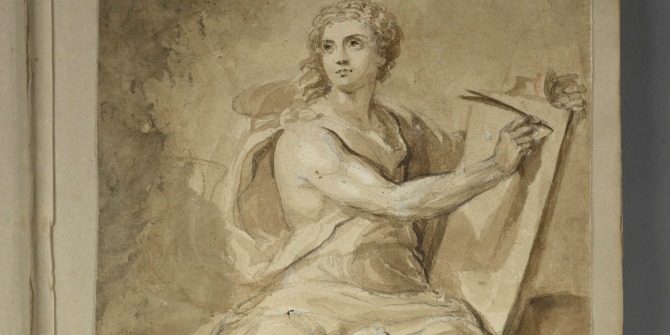 It has become a fact of academic life, that when researchers publish papers in academic journals, they sign away the copyright to their research, or licence it for distribution. However, from a historical perspective this practice is a relatively recent phenomenon. In this post Aileen Fyfe, explores how copyright has become intertwined with scholarly publishing and presents three insights from the history of the Royal Society that inform ongoing debates around openness in research and scholarly communication.
It has become a fact of academic life, that when researchers publish papers in academic journals, they sign away the copyright to their research, or licence it for distribution. However, from a historical perspective this practice is a relatively recent phenomenon. In this post Aileen Fyfe, explores how copyright has become intertwined with scholarly publishing and presents three insights from the history of the Royal Society that inform ongoing debates around openness in research and scholarly communication.
The protections offered by copyright have enabled authors – and their publishers – to make a living from their works since the first copyright act, for ‘the Encouragement of Learning’, was passed in 1710.
Academic authors, however, do not depend upon copyright for their livelihoods. Instead, for many researchers, copyright has come to seem like a tool used by publishers to pursue commercial, rather than scientific interests. Notably, open access advocates have long argued for changes to the ways researchers use copyright, a position that has recently found support in Plan S’ mandate for the use of Creative Commons licences as an alternative.
Understanding how we have reached this point is significant, as it highlights how attitudes to the copying, reprinting and sharing of research have developed over time. Here, I present three insights that shed light on the current state of scholarly publishing, drawn from my team’s research on the history of publishing at the Royal Society, and one of the earliest journals, The Philosophical Transactions.
- Scientific journals and the scholarly norms governing the reuse of research were developed outside the framework of copyright.
The Philosophical Transactions had been running for 45 years before the first UK copyright act was passed; and was 177 years old by the time periodical publications were included within the remit of the 1842 Copyright Act. By then, its editorial and authorial practices were well-established and were based on the norms of sociability that shaped the world of eighteenth-century gentlemanly scholars.
Authors who ‘presented’ a paper to the Royal Society in, say, the 1780s, were understood to be giving the Society a ‘present’: there was no exchange of money, but the Society acquired an ownership claim on both the physical manuscript and the findings it contained. In return, authors gained social capital, or prestige, as the Society’s processes ensured that their discoveries were recorded, dated, and attributed to them. The Society paid the costs of publishing papers in the Transactions and there was no expectation that sales would generate a profit for either publisher or author.
The social motivations for authoring and publishing scholarly research in this period meant that copyright legislation – designed to enable authors or their publishers to take action to prevent a loss of income – was irrelevant. The Royal Society doesn’t even appear to have formally registered its ownership of its journal titles after the 1842 act, a step which would have been essential if a legal case were to be pursued.
- Scholarly organisations were historically supportive of efforts to reprint, reuse and share research papers, so long as credit and priority were appropriately attributed.
Regardless of copyright, the Royal Society’s claim on the material published in the Transactions was widely recognised: authors, editors, and publishers, who wished to reprint the material, routinely sought and were granted permission to do so. Throughout the nineteenth century, the Society further assisted the dissemination of research by lending the engraved metal plates or lithographic stones used for the illustrations in the Transactions. For instance, the illustrations for Michael Faraday’s seminal papers on electromagnetism in the early 1830s, were repeatedly reused in his books until at least 1877. By that time, the Society was also routinely lending its illustrations to periodicals that reported scientific news, such as Nature and Chemical News.
The society expected no payment from those who reprinted or reused the Transactions papers, for it wished to encourage the circulation of knowledge. But it did expect attribution and acknowledgement. There were occasions when the Society did see reprinting or reuse as a threat, but the perceived threat was to reputation, not to income.
- Scholarly publishers became more alert to copyright legislation, as they became more interested in seeing commercial gain from publishing.
The Royal Society advised the government on a variety of issues throughout the nineteenth century; but not on copyright. Its absence from the (several) debates on copyright reform speaks to the distance between scholarly publishing and the commercially-focused book trade during this period.
The first example we have found of the Royal Society directly engaging with copyright legislation was in the 1950s. The introduction of micro-photography and photocopying led some publishers to argue that such copying would hurt their sales and was a breach of copyright. Learned society publishers, however, argued that photocopying would be a valuable means for individual researchers to make their own copy of the whole, or parts of research papers held by their institutional library, without having to copy it all out by hand. In 1950, the Royal Society led the creation of a voluntary code on ‘fair copying’, by which over a hundred publishers permitted the copying of journal papers for individual study or research. Equivalent provisions were included in the 1956 Copyright Act.
Learned societies had traditionally seen publishing as a means of sharing knowledge with the scholarly community, and of generating individual and especially institutional prestige. Reprinting and reuse helped to achieve that aim. But by the 1950s and 1960s, learned societies faced increased pressure to make their publishing activities financially sustainable; and the example of new commercial players suggested publishing could even become profitable.
The Royal Society had held copyright jointly with its authors in the mid-twentieth century, but in response to the 1988 Copyright Act, it now argued that owning copyright would give it control over income from ‘secondary rights, such as reprinting, reproduction and electronic document delivery’ (which, at the time, meant CD-ROMs or early computer networks). It introduced copyright transfer forms in 1990.
Open Research Now
It is the use of copyright transfer forms – in which academic authors freely give publishers the right to make money from publicly- or charitably-funded research – that has aroused so much opposition in recent years. As a result, the Royal Society is now one of several big publishers to have replaced copyright transfer with a licence agreement under which the author retains copyright. But some publishers have managed to craft licence agreements that are nearly as restrictive – in terms of sharing and reuse – as the copyright agreements they replaced. To find a way to alter or work around copyright’s commercial imperatives, in the name of improving the circulation and accessibility of research, we need the appropriate leadership. It needs both vision and scholarly credentials. In the 1950s, the Royal Society had both, but their commercially-successful publishing division has since come to overshadow the older vision. And in the intervening decades, both universities and government funding bodies have become more prominent in shaping research culture. With this history in mind, can we hope that UKRI and UUK and other international research funders will think creatively about copyright in academia?
About the Author:
Aileen Fyfe is a historian of science and technology who investigates the development of scholarly publishing practices. She is Professor of Modern History at the University of St Andrews, and leader of the ‘Publishing the Philosophical Transactions, 1665-2015’ project (in partnership with the Royal Society, and funded by AHRC grant AH/K001841). She was lead author of Untangling academic publishing: a history of the relationship between commercial interests, academic prestige and the circulation of research (2017); and is currently putting the finishing touches to a co-authored book-length study of the Philosophical Transactions. She can be found on twitter @aileenfyfe
A fuller discussion of points 1 and 2 of this post can be found in Aileen Fyfe, Julie McDougall-Waters, & Noah Moxham (2018), ‘Credit, copyright, and the circulation of scientific knowledge: the Royal Society in the long nineteenth century‘ published in Victorian Periodicals Review, open access version available here
Point 3 will be discussed in a forthcoming chapter; but readers interested in the 1950s ‘fair copying’ debate may like to consult Brad Sherman and Leanne Wiseman, ‘Fair Copy: Protecting Access to Scientific Information in Post-War Britain’, published in The Modern Law Review
Image Credit
Frontispiece to Volume 1 of Philosophical Transactions via Wikipedia (Licensed under a CC BY 4.0 licence)
Note: This article gives the views of the author, and not the position of the LSE Impact Blog, nor of the London School of Economics. Please review our comments policy if you have any concerns on posting a comment below.








All good points here, although there have always been concerns in the Royal Society around piracy ever since Oldenburg and issue 27 in 1667. Learned societies were as concerned as commercial journal publishers in the late 20th century around national piracy of journals, at least until China acceded to the WTO in 2001. I remember being part of a U.K. PA team including learned society publishers presenting to Chinese delegations in the late 1990s. Copyright/Licensing legal arguments did play a role in combating this at the time.